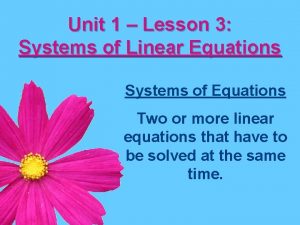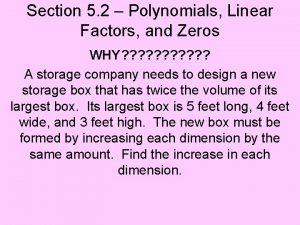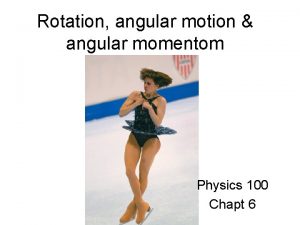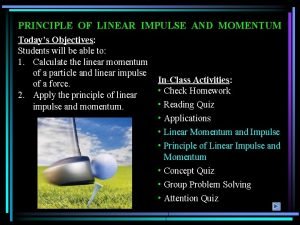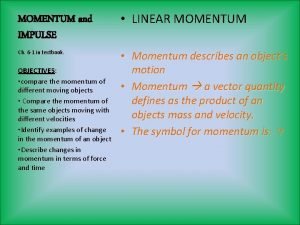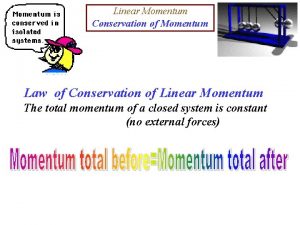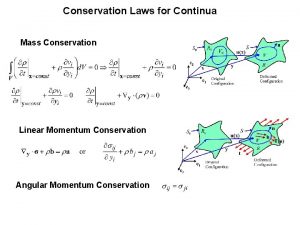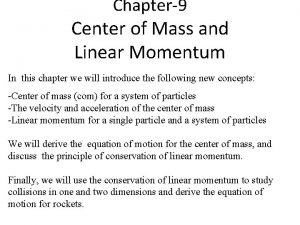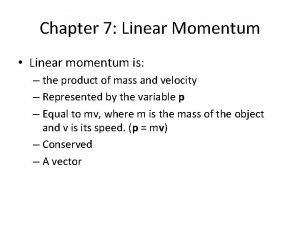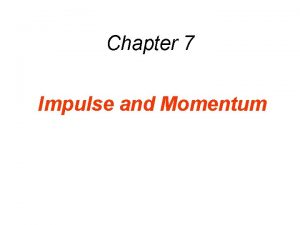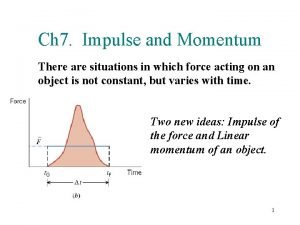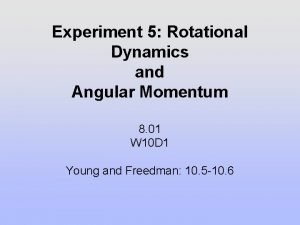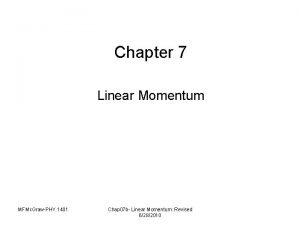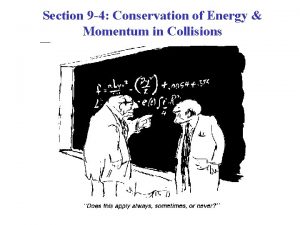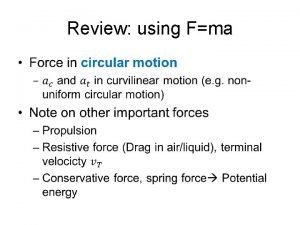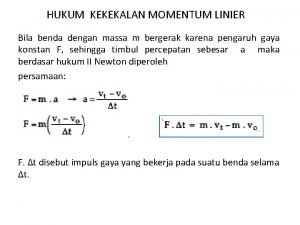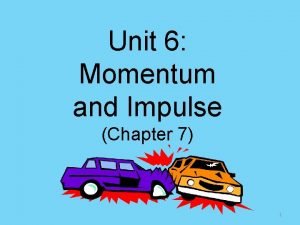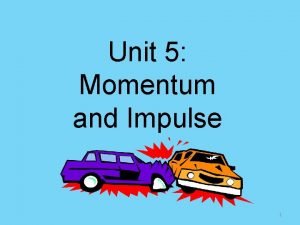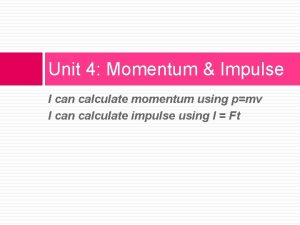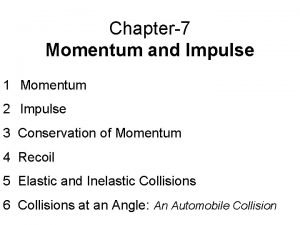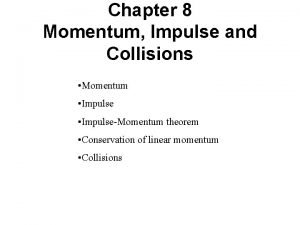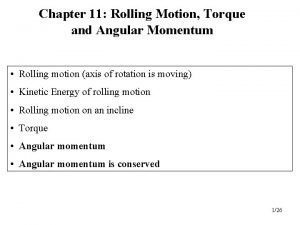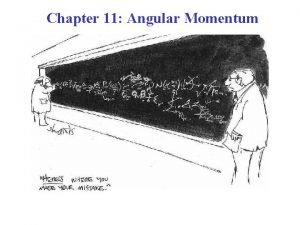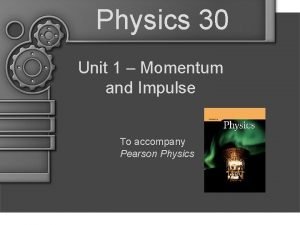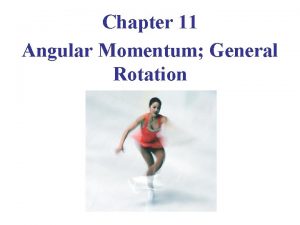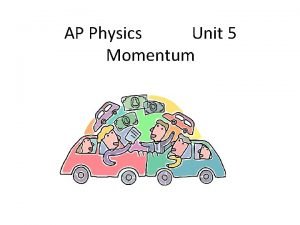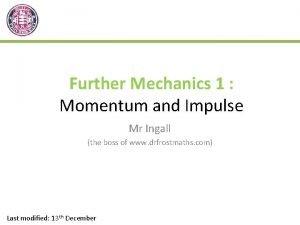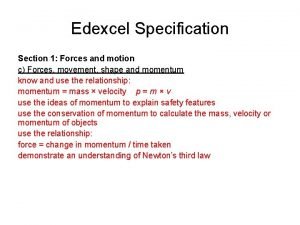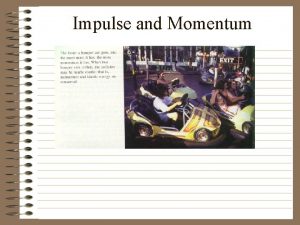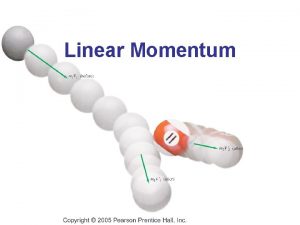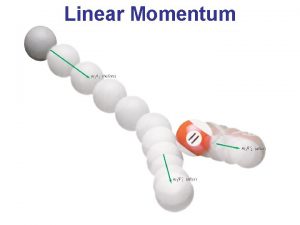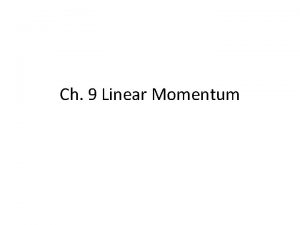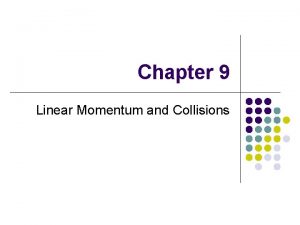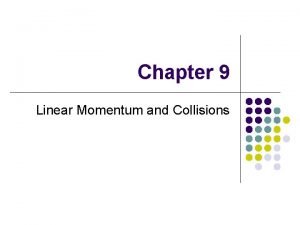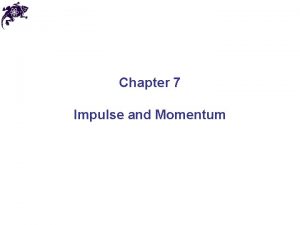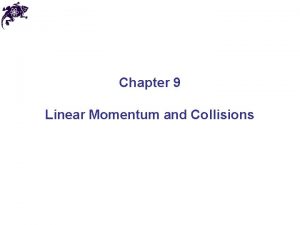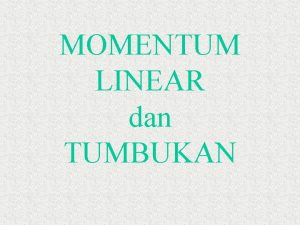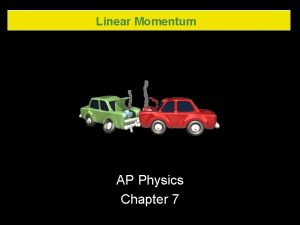Linear Momentum Unit 5 Lesson 1 Linear Momentum



























































- Slides: 59

Linear Momentum Unit 5

Lesson 1 : Linear Momentum and Its Conservation F 21 + F 12 = 0 (Newton’s Third Law) m 1 a 1 + m 2 a 2 = 0 (Newton’s Second Law) m 1 dv 2 + m 2 =0 dt dt d(m 1 v 1) d(m 2 v 2) + =0 dt dt

d dt (m 1 v 1 + m 2 v 2) = 0 sum of linear momentum is constant p = mv (linear momentum) Linear momentum is a vector quantity whose direction the same as the direction of v. Its SI unit is kg. m/s.

dv SF = ma = m dt SF = d(mv) dt = dp dt The time rate of change of the linear momentum of a particle is equal to the net force acting on the particle. (This is the form in which Newton presented his second law. )

Conservation of Linear Momentum Whenever two or more particles in an isolated system interact, the total momentum of the system remains constant. The total momentum of an isolated system at all times equals its initial momentum. Total p before = Total p after

Example 1 A 60. kg archer stands at rest on frictionless ice and fires a 0. 50 kg arrow horizontally at 50. m/s. a) With what velocity does the archer move across the ice after firing the arrow.

b) What if the arrow were shot in a direction that makes an angle q with the horizontal ? How will this change the recoil velocity of the archer ?

Example 2 Two blocks of masses M and 3 M are placed on a horizontal, frictionless surface. A light spring is attached to one of them, and the blocks are pushed together with the spring between them. A cord initially holding the blocks together is burned, and the 3 M block moves to the right with a speed of 2. 00 m/s.

a) What is the speed of the block of mass M ? b) Find the original elastic potential energy in the spring if M = 0. 350 kg.

Example 3 : AP 1981 #2 A swing seat of mass M is connected to a fixed point P by a massless cord of length L. A child also of mass M sits on the seat and begins to swing with zero velocity at a position at which the cord makes a 60 o angle with the vertical as shown in Figure I. The swing continues down until the cord is exactly vertical at which time the child jumps off in a horizontal direction.

The swing continues in the same direction until the cord makes a 45 o angle with the vertical as shown in Figure II; at that point it begins to swing in the reverse direction. With what velocity relative to the ground did the child leave the swing ? (cos 45 o = sin 45 o = 2 , sin 30 o = cos 60 o = ½, cos 30 o = sin 60 o = 3 2 ) 2

Lesson 2 : Impulse and Momentum SF = d(mv) dp = dt dt dp = F dt Integrating F with respect to t, Dp = pf – pi = ò tf F dt ti tf I= ò F dt ti Impulse (I)

Impulse is a vector quantity with the same direction as the direction of the change in momentum. Impulse has a magnitude equal to the area under the force-time graph.

Because the force imparting an impulse can generally vary in time, we can express impulse as I = FDt

Impulse – Momentum Theorem Dp = pf – pi = ò tf F dt ti The impulse of the force F acting on a particle equals the change in the momentum of the particle. I = Dp

Example 1 In a particular crash test, a car of mass 1500 kg collides with a wall, as shown. The initial and final velocities of the car ^ are vi = -15. 0 i m/s and ^ vf = 2. 60 i m/s, respectively.

a) If the collision lasts for 0. 150 s, find the impulse caused by the collision and the average force exerted on the car.

b) What if the car did not rebound from the wall ? Suppose the final velocity of the car is zero and the time interval of the collision remains 0. 150 s. Would this represent a larger or a smaller force by the wall on the car ?

Example 2 A 3. 00 kg steel ball strikes a wall with a speed of 10. 0 m/s at an angle of 60. 0 o with the surface. It bounces off with the same speed angle. If the ball is in contact with the wall for 0. 200 s, what is the average force exerted by the wall on the ball ?

Example 3 An estimated force-time curve for a baseball struck by a bat is shown above. From this curve, determine a) the impulse delivered to the ball

b) the average force exerted on the ball c) the peak force exerted on the ball

Lesson 3 : Collisions in One-Dimension Elastic Collisions Inelastic Collisions The total KE (as well as total momentum) of the system is the same before and after the collision. The total KE of the system is not the same before and after the collision (even though the momentum of the system is conserved). KE is conserved KE is not conserved “perfectly inelastic” “inelastic”

Perfectly Inelastic Collisions when the colliding objects stick together m 1 v 1 i + m 2 v 2 i = (m 1 + m 2)vf

Elastic Collisions m 1 v 1 i + m 2 v 2 i = m 1 v 1 f + m 2 v 2 f ½ m 1 v 1 i 2 + ½ m 2 v 2 i 2 = ½ m 1 v 1 f 2 + ½ m 2 v 2 f 2

Example 1 An 1800 kg car stopped at a traffic light is struck from the rear by a 900 kg car, and the two become entangled, moving along the same path as that of the originally moving car. a) If the smaller car were moving at 20. 0 m/s before the collision, what is the velocity of the entangled cars after the collision ?

b) Suppose we reverse the masses of the cars – a stationary 900 kg car is struck by a moving 1800 kg car. Is the final speed the same as before ?

Example 2 The ballistic pendulum is an apparatus used to measure the speed of a fast-moving projectile, such as a bullet. A bullet of mass m 1 is fired into a large block of wood of mass m 2 suspended from some light wires. The bullet embeds in the block, and the entire system swings through a height h. How can we determine the speed of the bullet from a measurement of h ?

Example 3 A block of mass m 1 = 1. 60 kg initially moving to the right with a speed of 4. 00 m/s on a frictionless horizontal track collides with a spring attached to a second block of mass m 2 = 2. 10 kg initially moving to the left with a speed of 2. 50 m/s. The spring constant is 600 N/m.

a) Find the velocities of the two blocks after the collision.

b) During the collision, at the instant block 1 is moving to the right with a velocity of +3. 00 m/s, determine the velocity of block 2.

Example 4 : AP 1995 #1 A 5 kg ball initially at rest at the edge of a 2 m long, 1. 2 m high frictionless table, as shown above. A hard plastic cube of mass 0. 5 kg slides across the table at a speed of 26 m/s and strikes the ball, causing the ball to leave the table in the direction in which the cube was moving.

The figure below shows a graph of the force exerted on the ball by the cube as a function of time. a) Determine the total impulse given to the ball.

b) Determine the horizontal velocity of the ball immediately after the collision. c) Determine the following for the cube immediately after the collision. i. Its speed ii. Its direction of travel (right or left), if moving

d) Determine the kinetic energy dissipated in the collision. e) Determine the distance between the two points of impact of the objects with the floor.

Example 5 : AP 1994 #1 A 2 kg block and an 8 kg block are both attached to an ideal spring (for which k = 200 N/m) and both are initially at rest on a horizontal frictionless surface, as shown in the diagram above. In an initial experiment, a 100 g (0. 1 kg) ball of clay is thrown at the 2 kg block. The clay is moving horizontally with speed v when it hits and sticks to the block. The 8 kg block is held still by a removable stop. As a result, the spring compresses a maximum distance of 0. 4 m.

a) Calculate the energy stored in the spring at maximum compression. b) Calculate the speed of the clay ball and 2 kg block immediately after the clay sticks to the block but before the spring compresses significantly.

c) Calculate the initial speed v of the clay. In a second experiment, an identical ball of clay is thrown at another identical 2 kg block, but this time the stop is removed so that the 8 kg block is free to move. d) State whether the maximum compression of the spring will be greater than, equal to, or less than 0. 4 m. Explain briefly.

e) State the principle or principles that can be used to calculate the velocity of the 8 kg block at the instant that the spring regains its original length. Write the appropriate equation(s) and show the numerical substitutions, but do not solve for the velocity.

Lesson 4 : Two-Dimensional Collisions m 1 v 1 i = m 1 v 1 f cosq + m 2 v 2 f cosf 0 = m 1 v 1 f sinq - m 2 v 2 f sinf

Since this is an elastic collision, KE is also conserved. * ½ m 1 v 1 i 2 = ½ m 1 v 1 f 2 + ½ m 2 v 2 f 2 * If this were an inelastic collision, KE would not be conserved, and this equation does not apply.

Example 1 A 1500 kg car traveling east with a speed of 25. 0 m/s collides at an intersection with a 2500 kg van traveling north at a speed of 20. 0 m/s. Find the direction and magnitude of the velocity of the wreckage after the collision, assuming that the vehicles undergo a perfectly inelastic collision (that is, they stick together).

Example 2 In a game of billiards, a player wishes to sink a target ball in the corner pocket. If the angle to the corner pocket is 35 o, at what angle q is the cue ball deflected ? Assume that friction and rotational motion are unimportant and that the collision is elastic. Also assume that all billiard balls have the same mass m.

Lesson 5 : The Center of Mass Center of mass (CM) is the average position of the system’s mass Center of mass is located on the line joining the two particles and is closer to the particle having the larger mass.

How to Locate the Center of Mass System rotates clockwise when F is applied between the less massive particle and CM. System rotates counterclockwise when F is applied between the more massive particle and CM. System moves in the direction of F without rotating when F is applied at CM.

x. CM = m 1 x 1 + m 2 x 2 m 1 + m 2

Center of mass for a system of many particles x. CM = m 1 x 1 + m 2 x 2 + m 3 x 3 + …… m 1 + m 2 + m 3 + …… x. CM = Smixi M Y coordinates of CM y. CM = Smiyi M Z coordinates of CM z. CM = Smizi M

Using a Position Vector (r) to locate CM of a system of particles ^ ^ ^ r. CM = x. CM i + y. CM j + z. CM k Using a Position Vector (r) to locate CM of an extended object x. CM = lim Dmi 0 Sxi. Dmi M

x. CM 1 = M ò x dm (likewise for y. CM and z. CM) r. CM 1 = M ò r dm

Locating CM of an irregularly shaped object Suspend the object first from points A and C. CM is where lines AB and CD intersect If wrench is hung freely from any point, the vertical line through this point must pass through CM.

Example 1 A baseball bat is cut at the location of its center of mass. The piece with smaller mass is a) the piece on the right. b) the piece on the left. c) both have same mass. d) impossible to determine.

Example 2 A system of three particles located as shown above. Find the center of mass of the system.

Example 3 a) Show that the center of mass of a rod of mass M and length L lies midway between its ends, assuming the rod has a uniform mass per unit length.

b) Suppose a rod is nonuniform such that its mass per unit length varies linearly with x according to the expression l = ax, where a is a constant. Find the x coordinate of the center of mass as a fraction of L.

Lesson 6 : Motion of a System of Particles Velocity of CM v. CM = dr. CM dt Acceleration of CM a. CM = dv. CM dt

Total momentum of a system of particles Mv. CM = Smivi = Spi = ptot total mass of system (i is the ith particle) Newton’s Second Law for a system of particles SFext = Ma. CM CM of a system of particles of combined mass M moves like an equivalent particle of mass M would move under the influence of the net external force on the system.

Example 1 Suppose you tranquilize a polar bear on a smooth glacier as part of a research effort. How might you estimate the bear’s mass using a measuring tape, a rope, and knowledge of your own mass ?

Example 2 Consider a system of two particles in the xy plane : ^ ^ m 1 = 2. 00 kg is at r 1 = (1. 00 i + 2. 00 j) m and ^ ^ has a velocity of (3. 00 i + 0. 500 j) m/s ^ ^ m 2 = 3. 00 kg is at r 2 = (-4. 00 i - 3. 00 j) m and ^ ^ has a velocity of (3. 00 i – 2. 00 j) m/s a) Plot these particles on a grid or graph paper. Draw their position vectors and show their velocities.

b) Find the CM of the system and mark it on the grid. c) Determine the velocity of the CM and also show it on the diagram. d) What is the total linear momentum of the system ?

Example 3 A rocket is fired vertically upward. At the instant it reaches an altitude of 1000 m and a speed of 300 m/s, it explodes into three fragments having equal mass. One fragment continues to move upward with a speed of 450 m/s following the explosion. The second fragment has a speed of 240 m/s and is moving east right after the explosion. What is the velocity of the third fragment right after the explosion ?
 Linear momentum and linear impulse
Linear momentum and linear impulse Chapter 6 momentum changing momentum
Chapter 6 momentum changing momentum Lesson 3 linear equations in x
Lesson 3 linear equations in x Unit 6 lesson 2 polynomials linear factors and zeros
Unit 6 lesson 2 polynomials linear factors and zeros Right triangle trigonometry examples
Right triangle trigonometry examples Unit 6 review questions
Unit 6 review questions Iw^2 physics
Iw^2 physics Linear impulse momentum equation
Linear impulse momentum equation How does impulse relate to momentum
How does impulse relate to momentum Law of conservation of momentum animation
Law of conservation of momentum animation Conservation of linear momentum
Conservation of linear momentum Center of mass and linear momentum
Center of mass and linear momentum Does an elastic collision conserve momentum
Does an elastic collision conserve momentum Define linear momentum and impulse
Define linear momentum and impulse Pengertian hukum kekekalan momentum
Pengertian hukum kekekalan momentum Whats linear momentum
Whats linear momentum Impulse momentum theorem definition
Impulse momentum theorem definition Conservation of linear momentum
Conservation of linear momentum Velocity center of mass equation
Velocity center of mass equation Angular momentum of disc
Angular momentum of disc Linear momentum
Linear momentum The law of conservation of momentum
The law of conservation of momentum Average linear momentum
Average linear momentum Momentum linear adalah
Momentum linear adalah When is momentum conserved
When is momentum conserved Contoh soal momentum
Contoh soal momentum Unit 6 momentum and impulse
Unit 6 momentum and impulse Impulse law
Impulse law Unit for momentum
Unit for momentum The units for impulse are
The units for impulse are Impulse and momentum
Impulse and momentum Unit for momentum
Unit for momentum The momentum principle
The momentum principle Si unit of angular momentum
Si unit of angular momentum Angular momentum is scalar or vector
Angular momentum is scalar or vector Momentum and impulse physics 30
Momentum and impulse physics 30 Momentum
Momentum Unit 5 momentum 5.a center of mass
Unit 5 momentum 5.a center of mass Further mechanics 1 unit test 1 momentum and impulse
Further mechanics 1 unit test 1 momentum and impulse What is momentum
What is momentum Is momentum a force
Is momentum a force Lesson outline lesson 3 describing circuits answers
Lesson outline lesson 3 describing circuits answers Lesson outline lesson 3 mountain building answers
Lesson outline lesson 3 mountain building answers Lesson outline lesson 2 aquatic ecosystems answer key
Lesson outline lesson 2 aquatic ecosystems answer key Macro teaching lesson plan
Macro teaching lesson plan Ihi leadership alliance
Ihi leadership alliance The beggar learning objectives
The beggar learning objectives An overall state of well-being or total health
An overall state of well-being or total health Lesson outline lesson 3 weather forecasts answer key
Lesson outline lesson 3 weather forecasts answer key Sat vocabulary lesson and practice lesson 4
Sat vocabulary lesson and practice lesson 4 Lesson outline physical properties lesson 2
Lesson outline physical properties lesson 2 The science duo physical and chemical changes
The science duo physical and chemical changes Lesson outline lesson 1 climates of earth answers key
Lesson outline lesson 1 climates of earth answers key Lesson outline lesson 1
Lesson outline lesson 1 Measurement and scientific tools lesson 2
Measurement and scientific tools lesson 2 Fingerprint ridge characteristics worksheet
Fingerprint ridge characteristics worksheet Lesson 1 land biomes answer key
Lesson 1 land biomes answer key Lesson 4 gravity and motion lesson review
Lesson 4 gravity and motion lesson review Lesson outline lesson 2 the muscular system answer key
Lesson outline lesson 2 the muscular system answer key Lesson outline lesson 2 wave properties answer key
Lesson outline lesson 2 wave properties answer key


